湘潭电机使用维护说明书
- 格式:pdf
- 大小:188.54 KB
- 文档页数:14

电动机维护保养作业指导书XXXX纸业集团股份有限公司铜版纸工厂动力车间名称电动机维护保养作业指导书修订时间2008-10-16 版本 01 编号TBZDQ10 页数 4 适用范围电动机维护保养作业一.需用工具:梅花扳手,活扳手,测温仪,抹布二.具体内容:1.电动机维护保养规范1.1检查:新电动机在使用前,需做以下检查1.1.1电动机开箱前检查包装是否完好无损,有无受潮的迹象。
1.1.2电动机开箱后应小心清除电动机上的尘土及防锈层。
1.1.3详细核对铭牌上的所载的各项数据,如额定功率、电压、频率、转速、接线方式等是否与实际需要相符。
1.1.4仔细检查电动机在运输过程中,有无变形或损坏,紧固件是否有松动或脱落,试用手转动电动机是否灵活。
1.1.5用500 伏兆欧表测量绝缘电阻,其值不小于 0.5 兆欧。
否则应对定子进行干燥处理或供公司联系生产厂家进行处理。
高压电机使用 2500伏兆欧表测量.2、安装 :新电机在安装时应注意以下问题2.1在电动机安装过程中,不允许大的冲击性轴向力,以免损坏轴承。
2.2安装时,应该保证电动机有良好的通风条件,风罩进风端留的空间不得小于下表的规定。
mm机座型号63~132 160~180 200~355空间25 30 502.3接线盒的填料函方向,可在轴伸方向以外的其它三个方向进行调换,当需要重新确定接线盒方向时,可取下接线盒的四个螺丝,将接线盒移位。
2.4在接线时将填料函内的橡皮圈穿孔后进行接线,并将压紧螺母拧紧,达到防水防震的要求。
2.5安装完毕,应检查各紧固件、联接件是否可靠,用手转动应轻松无磨擦。
3、运转3.1电动机的接线方法应按铭牌或接线盒上标明的方法连接。
3.2电动机安装必须严格按照铭牌上标明的安装方式进行安装。
3.3立式电动机在使用时不允许有任何轴向负载。
3.4电动机应妥善接地,接线内有接地装置。
必要时,也可利电动机的底脚进行接地。
3.5电动机在实际负载运转中应持续观察其起动情况,运行时声音是否正常,及电动机运行电流是否超过额定电流,在运行一段时间后应检查电动机接线等连接部分有无松动,轴承有无过热及漏油。
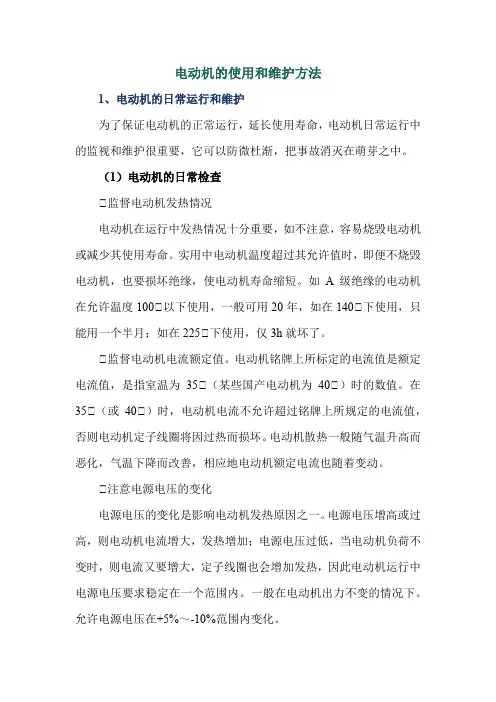
电动机的使用和维护方法1、电动机的日常运行和维护为了保证电动机的正常运行,延长使用寿命,电动机日常运行中的监视和维护很重要,它可以防微杜渐,把事故消灭在萌芽之中。
(1)电动机的日常检查①监督电动机发热情况电动机在运行中发热情况十分重要,如不注意,容易烧毁电动机或减少其使用寿命。
实用中电动机温度超过其允许值时,即便不烧毁电动机,也要损坏绝缘,使电动机寿命缩短。
如A级绝缘的电动机在允许温度100①以下使用,一般可用20年,如在140①下使用,只能用一个半月;如在225①下使用,仅3h就坏了。
①监督电动机电流额定值。
电动机铭牌上所标定的电流值是额定电流值,是指室温为35①(某些国产电动机为40①)时的数值。
在35①(或40①)时,电动机电流不允许超过铭牌上所规定的电流值,否则电动机定子线圈将因过热而损坏。
电动机散热一般随气温升高而恶化,气温下降而改善,相应地电动机额定电流也随着变动。
①注意电源电压的变化电源电压的变化是影响电动机发热原因之一。
电源电压增高或过高,则电动机电流增大,发热增加;电源电压过低,当电动机负荷不变时,则电流又要增大,定子线圈也会增加发热,因此电动机运行中电源电压要求稳定在一个范围内。
一般在电动机出力不变的情况下。
允许电源电压在+5%~-10%范围内变化。
①注意三相电压和三相电流的不平衡程度三相电压的不平衡也会引起电动机的额外发热。
电动机在运行中,应检查其三相电压是否平衡。
三相电压的不平衡程度在额定功率下,允许相间电压差不大于5%;电动机的三相电压不平衡,电流也要出现相应地不平衡;或者由于定子绕组三相阻抗的不相等,也会造成电流的不平衡。
一般情况,电动机三相电流的不平衡不是由三相电源电压引起的,而是表明电动机有故障或定子绕组有层间短路现象。
一般三相电流的不平衡程度不允许大于10%,严重的三相电流不平衡一般是由一相熔丝熔断造成电动机单相运行所致。
①注意电动机的振动电动机振动过大,必须详细检查基础是否牢固,地脚螺钉是否松动,带轮或联轴器是否松动等。
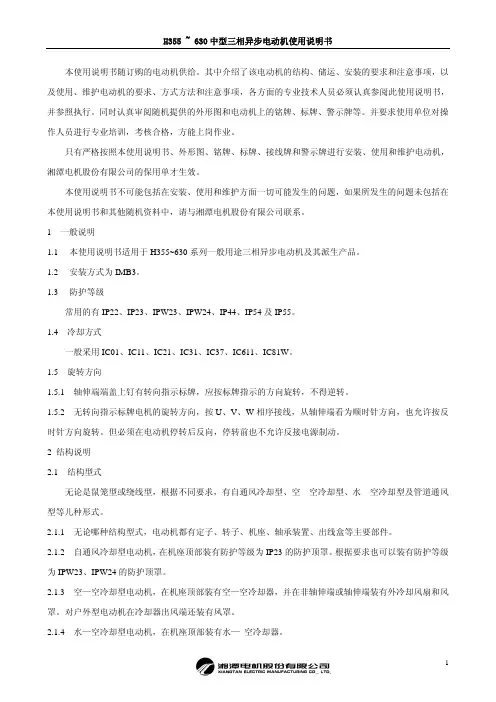
本使用说明书随订购的电动机供给。
其中介绍了该电动机的结构、储运、安装的要求和注意事项,以及使用、维护电动机的要求、方式方法和注意事项,各方面的专业技术人员必须认真参阅此使用说明书,并参照执行。
同时认真审阅随机提供的外形图和电动机上的铭牌、标牌、警示牌等。
并要求使用单位对操作人员进行专业培训,考核合格,方能上岗作业。
只有严格按照本使用说明书、外形图、铭牌、标牌、接线牌和警示牌进行安装、使用和维护电动机,湘潭电机股份有限公司的保用单才生效。
本使用说明书不可能包括在安装、使用和维护方面一切可能发生的问题,如果所发生的问题未包括在本使用说明书和其他随机资料中,请与湘潭电机股份有限公司联系。
1 一般说明1.1本使用说明书适用于H355~630系列一般用途三相异步电动机及其派生产品。
1.2安装方式为IMB3。
1.3防护等级常用的有IP22、IP23、IPW23、IPW24、IP44、IP54及IP55。
1.4 冷却方式一般采用IC01、IC11、IC21、IC31、IC37、IC611、IC81W。
1.5 旋转方向1.5.1 轴伸端端盖上钉有转向指示标牌,应按标牌指示的方向旋转,不得逆转。
1.5.2 无转向指示标牌电机的旋转方向,按U、V、W相序接线,从轴伸端看为顺时针方向,也允许按反时针方向旋转。
但必须在电动机停转后反向,停转前也不允许反接电源制动。
2 结构说明2.1 结构型式无论是鼠笼型或绕线型,根据不同要求,有自通风冷却型、空—空冷却型、水—空冷却型及管道通风型等几种形式。
2.1.1 无论哪种结构型式,电动机都有定子、转子、机座、轴承装置、出线盒等主要部件。
2.1.2 自通风冷却型电动机,在机座顶部装有防护等级为IP23的防护顶罩。
根据要求也可以装有防护等级为IPW23、IPW24的防护顶罩。
2.1.3 空—空冷却型电动机,在机座顶部装有空—空冷却器,并在非轴伸端或轴伸端装有外冷却风扇和风罩。
对户外型电动机在冷却器出风端还装有风罩。
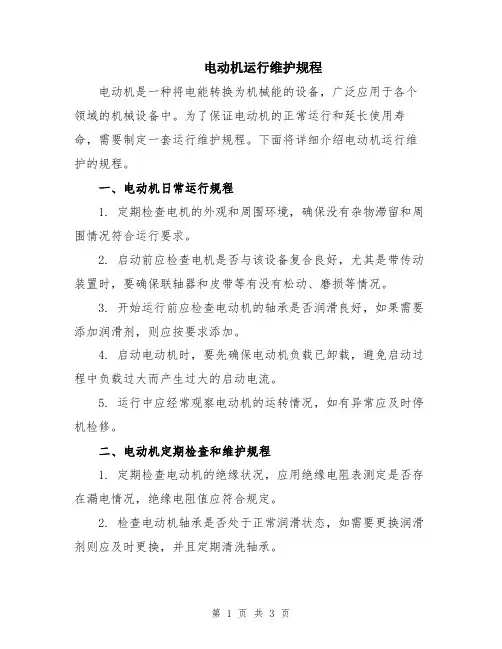
电动机运行维护规程电动机是一种将电能转换为机械能的设备,广泛应用于各个领域的机械设备中。
为了保证电动机的正常运行和延长使用寿命,需要制定一套运行维护规程。
下面将详细介绍电动机运行维护的规程。
一、电动机日常运行规程1. 定期检查电机的外观和周围环境,确保没有杂物滞留和周围情况符合运行要求。
2. 启动前应检查电机是否与该设备复合良好,尤其是带传动装置时,要确保联轴器和皮带等有没有松动、磨损等情况。
3. 开始运行前应检查电动机的轴承是否润滑良好,如果需要添加润滑剂,则应按要求添加。
4. 启动电动机时,要先确保电动机负载已卸载,避免启动过程中负载过大而产生过大的启动电流。
5. 运行中应经常观察电动机的运转情况,如有异常应及时停机检修。
二、电动机定期检查和维护规程1. 定期检查电动机的绝缘状况,应用绝缘电阻表测定是否存在漏电情况,绝缘电阻值应符合规定。
2. 检查电动机轴承是否处于正常润滑状态,如需要更换润滑剂则应及时更换,并且定期清洗轴承。
3. 定期检查电动机的冷却系统,确保冷却风扇转动灵活,散热器不堵塞,避免因过热而引起电动机故障。
4. 清洗电动机外壳,确保电动机的散热性能良好,同时检查外壳是否存在腐蚀或损坏情况。
5. 定期检查电动机的电气连接,确保接线良好,无松动或断裂情况,同时检查电动机的继电器和保险丝是否正常。
6. 检查电动机的电流和电压值是否在正常范围内,若有异常情况应及时进行检修。
7. 检查电动机的整体情况,如有损坏或变形情况应及时更换或修复。
三、电动机故障排除规程1. 当电动机运行不正常时,应先检查电源是否供电正常,电动机的保护装置是否正常工作。
2. 如果电源供电正常,应检查电动机的机械部分,如轴承是否磨损、联轴器是否松动等。
3. 如果机械部分正常,应检查电动机的电气连接和电气部分,如继电器、保险丝、接线端子等是否损坏或断裂。
4. 如果以上检查都没有问题,应使用仪器检测电动机的绝缘状况,确定是否存在绝缘故障。

电动机的检修维护规程范本一、引言电动机是现代工业生产中常见的设备,其稳定运行对于保证生产的连续性和高效率至关重要。
为了确保电动机的正常运行,需要进行定期的检修和维护工作。
本文将介绍电动机的检修维护规程,以帮助操作人员正确、有效地进行电动机的维护工作。
二、检修工具准备1. 扳手、梅花扳手、螺丝刀等常见工具2. 电压表、万用表等电气测量工具3. 绝缘测试仪、绝缘棒等绝缘测试工具4. 温度计、震动仪等检测工具5. 清洁工具,如喷气枪、刷子、吸尘器等三、外观及检查1. 检查电机外壳是否有异常现象,如变形、破损等。
2. 检查终端盖是否完好,没有松动。
3. 检查接线盒、端子是否紧固,无烧焦痕迹和松动。
4. 检查电机通风口是否清洁,无积尘或异物堵塞。
5. 检查轴承润滑状态,是否需要加油或更换润滑脂。
四、电气检测1. 使用电压表、万用表等电气测量工具,检测电机的绝缘电阻。
2. 使用绝缘测试仪、绝缘棒等绝缘测试工具,对电机的绝缘性能进行测试。
3. 检测电机的绝缘电阻是否符合标准要求。
4. 检测电机的绝缘电阻是否稳定,无异常波动。
5. 检测电机的接地是否正常,接地电阻是否合格。
五、润滑检查1. 检查轴承润滑油位,是否需要补充润滑油。
2. 检查润滑脂的浓度和黏度,是否需要更换润滑脂。
3. 检查润滑系统的工作情况,是否存在渗漏或堵塞现象。
4. 清洁润滑系统,确保润滑油的清洁度和正常流动。
六、热度检查1. 使用温度计等检测工具,测量电机各部件的表面温度。
2. 检测电机的温度是否超过允许的范围。
3. 检测电机运行时是否存在过热现象,如异味、烟雾等。
七、震动检查1. 使用震动仪等检测工具,检测电机运行时的震动情况。
2. 检测电机是否存在异常的振动频率和幅度。
3. 检测电机支撑结构是否稳固,是否松动。
八、清洁工作1. 使用喷气枪、刷子等清洁工具,清洁电机的外壳和通风口。
2. 使用吸尘器等清洁工具,清洁电机的内部,清除积尘和异物。
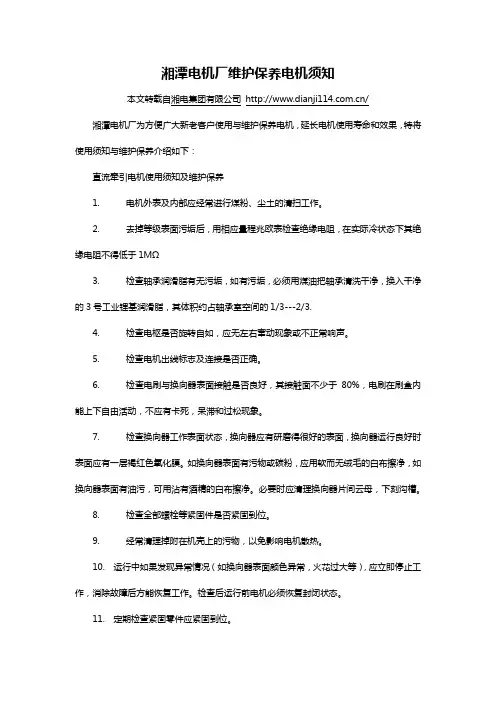
湘潭电机厂维护保养电机须知本文转载自湘电集团有限公司/ 湘潭电机厂为方便广大新老客户使用与维护保养电机,延长电机使用寿命和效果,特将使用须知与维护保养介绍如下:直流牵引电机使用须知及维护保养1. 电机外表及内部应经常进行煤粉、尘土的清扫工作。
2. 去掉等级表面污垢后,用相应量程兆欧表检查绝缘电阻,在实际冷状态下其绝缘电阻不得低于1MΩ3. 检查轴承润滑脂有无污垢,如有污垢,必须用煤油把轴承清洗干净,换入干净的3号工业锂基润滑脂,其体积约占轴承室空间的1/3---2/3.4. 检查电枢是否旋转自如,应无左右窜动现象或不正常响声。
5. 检查电机出线标志及连接是否正确。
6. 检查电刷与换向器表面接触是否良好,其接触面不少于80%,电刷在刷盒内能上下自由活动,不应有卡死,呆滞和过松现象。
7. 检查换向器工作表面状态,换向器应有研磨得很好的表面,换向器运行良好时表面应有一层褐红色氧化膜。
如换向器表面有污物或碳粉,应用软而无绒毛的白布擦净,如换向器表面有油污,可用沾有酒精的白布擦净。
必要时应清理换向器片间云母,下刻沟槽。
8. 检查全部螺栓等紧固件是否紧固到位。
9. 经常清理掉附在机壳上的污物,以免影响电机散热。
10. 运行中如果发现异常情况(如换向器表面颜色异常,火花过大等),应立即停止工作,消除故障后方能恢复工作。
检查后运行前电机必须恢复封闭状态。
11. 定期检查紧固零件应紧固到位。
12. 换向器在运行中常见故障及原因如下①换向器表面有沟槽原因:电刷硬度太大或有硬度大的颗粒。
②换向器所有铜片均发黑原因:换向极极性不对,换向极强弱未调整好,电刷压力不对。
③电刷及附件发热原因:电刷下火花大,电刷与连接线接触处接触不良,连接线横截面积太小。
④电刷下火花大原因:电机过负载,换向器表面不洁净、不平滑或不圆,换向片或云母片凸出,电刷磨合不好,弹簧压力太小,电刷牌号不对,电刷在刷盒内不活动,刷握松动,换向极极性不对,换向极气隙不对。
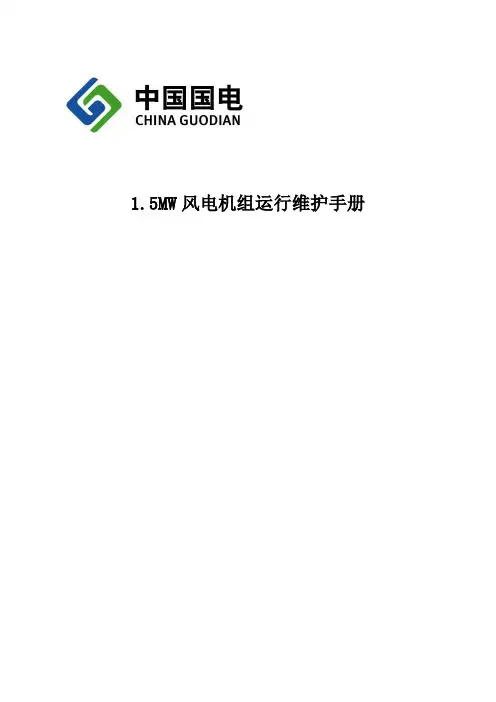
1.5MW风电机组运行维护手册作业指导书Operation Guidance Book文件名称:《1.5MW风电机组运行维护手册》文件版本号:GP/WI-031文件编号:GDSD-T-WI011编制:校对:审核:批准:生效日期:2012年8月1日目录1. 目的 (1)2. 适用范围 (1)3. 职责 (1)4.维护类型介绍及作用 (2)4.1试车首检和500小时维护 (2)4.1.1 风机试车一周后首检 (2)4.1.2 500小时维护 (3)4.2风机的定期维护 (3)5、叶片维护 (5)5.1叶片表面检查与维护 (5)5.2 叶片噪音检查 (5)5.3雷电保护系统检查与维护 (6)5.4 排水孔的检查与维护 (6)5.5 叶片螺栓的检查和维护 (6)6.轮毂和变桨系统维护 (7)6.1轮毂整体外观检查与维护 (7)6.2 螺栓的检查与维护 (7)6.3 润滑系统的检查与维护 (8)6.5 变桨齿轮箱的检查与维护 (10)6.6 变桨电机的检查与维护 (11)6.7 转速传感器的检查与维护 (11)6.8 叶片角度校准 (12)6.9 伺服控制器的检查与维护 (12)6.10 轴柜检查与维护 (12)6.11主控柜检查与维护 (12)6.12电池柜检查与维护 (13)7、主轴维护 (13)7.1 常规检查 (13)7.2 接油盒的检查与维护 (14)7.3 检查所有螺栓是否松动 (14)7.4 主轴润滑维护 (14)8、偏航系统维护 (15)8.1 表面检查与维护 (15)8.2 偏航紧固件检查与维护 (15)9、液压系统维护(含刹车系统) (18)9.1 液压系统的检查与维护 (18)9.2 刹车系统的检查与维护 (20)10、齿轮箱系统维护 (22)10.1 齿轮箱外表检查与维护 (22)10.3 齿轮箱润滑油检查与维护 (24)10.4 更换齿轮箱油滤芯 (26)10.5更换齿轮箱润滑油 (27)10.6 齿轮箱油冷却系统的检查与维护 (27)10.7齿箱冷却风扇及软连接通道检查(风冷系统) (28)11、滑环的维护 (29)11.1 外观检查 (29)11.2 电刷维护 (29)12、发电机维护 (29)12.1 发电机表面检查 (29)12.2 检查发电机螺栓 (30)12.3检查发电机接线 (30)12.4 整体清洁 (30)12.5轴承维护 (31)12.6发电机润滑 (31)12.7 柔性联轴器维护 (32)12.7.1 联轴器外观检查与维护 (32)12.7.2 距离检查 (32)12.7.3 螺栓检查 (32)12.7.4对中检测 (33)13、机舱及其附件的维护 (33)13.3 风速仪风向标及航标灯检查 (34)13.4罩体修复 (35)14、塔筒及塔筒内电缆维护 (35)14.1非紧固件、门外梯子的检查维护 (35)14.2塔筒门的检查 (35)14.3检查塔筒的防腐情况 (36)14.4检查内部照明和紧急照明 (36)14.5检查攀爬保护系统 (36)14.6灭火器的检查 (36)14.7检查梯子 (36)14.8检查平台 (37)14.9检查接地线 (37)14.10 检查塔筒内的电缆 (37)14.11焊缝检查 (37)14.12紧固件检查 (38)15、基础及防腐系统维护 (38)15.1 基础的检查与维护 (38)15.2 防腐系统维护 (39)16、控制功能检查及维护 (40)16.1控制柜及变流器维护 (40)16.1.1 塔底柜检查与维护 (40)16.1.2 机舱柜检查与维护 (41)16.2 风机故障屏蔽 (42)16.3急停功能测试 (42)16.4不间断电源检查 (42)16.4机舱加热器检查 (43)16.5安全链功能检查 (43)17、变流器的检查与维护 (44)18、其它附件维护 (44)19.附录 (44)附录1:螺栓维护力矩表 (44)附录2:维护工具清单 (50)附录3、易耗品更换标准 (1)前言本作业指导书适用于国电联合动力技术有限公司并网型陆(地)上双馈风力发电机组现场运行、维护工作,作为现场施工作业指导。
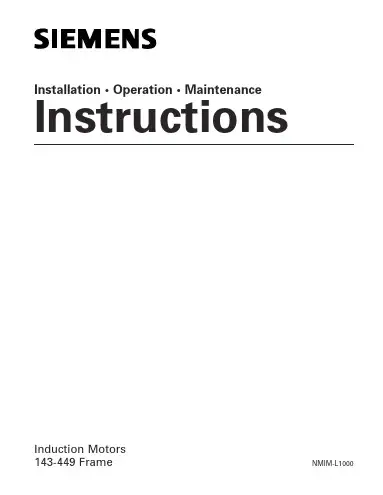
Installation • Operation • Maintenance InstructionsInduction MotorsTABLE OF CONTENTSINSPECTION. . . . . . . . . . . . . . . . . . . . . . . . . . . . . . . . . . . . . . . . . . . . . . . . . 4STORAGE. . . . . . . . . . . . . . . . . . . . . . . . . . . . . . . . . . . . . . . . . . . . . . . . . . . 4INSTALLATION. . . . . . . . . . . . . . . . . . . . . . . . . . . . . . . . . . . . . . . . . . . . . . . 4OPERATION. . . . . . . . . . . . . . . . . . . . . . . . . . . . . . . . . . . . . . . . . . . . . . . . . 5VOLTAGE REGULATION. . . . . . . . . . . . . . . . . . . . . . . . . . . . . . . . . . . . . . . . 6MAINTENANCE. . . . . . . . . . . . . . . . . . . . . . . . . . . . . . . . . . . . . . . . . . . . . . 7•BEARING LUBRICATION. . . . . . . . . . . . . . . . . . . . . . . . . . . . . . . . . . . . . 7•INSULATION RESISTANCE. . . . . . . . . . . . . . . . . . . . . . . . . . . . . . . . . . . 7•CLEANING. . . . . . . . . . . . . . . . . . . . . . . . . . . . . . . . . . . . . . . . . . . . . . . . 8VERTICAL MOTOR THRUST BEARINGS. . . . . . . . . . . . . . . . . . . . . . . . . . . 8SERVICE. . . . . . . . . . . . . . . . . . . . . . . . . . . . . . . . . . . . . . . . . . . . . . . . . . . . 8These instructions do not purport to cover all details or variations in equipment, nor to provide for every possible contingency to be met in connection with installation, operation or maintenance. Should further information be desired or should particular problems arise which are not covered suf-ficiently for the purchaser’s purposes, the matter should be referred to the local Siemens Sales Office. The contents of this instruction manual shall not become part or modify any prior or existing agree-ment, commitment or relationship. The sales contract contains the entire obligation of Siemens. The warranty contained in the contract between the parties is the sole warranty of Siemens. Any statements contained herein do not create new warranties or modify the existing warranty.INDUSTRIAL MOTOR DIVISIONINTRODUCTIONTHIS EQUIPMENT CONTAINS HAZARDOUS VOLTAGES, ROTATING PARTS AND HOT SURFACES. SEVERE PERSONAL INJURY OR PROPERTY DAMAGE CAN RESULT IF SAFETY INSTRUCTIONS ARE NOT FOLLOWED. ONLY QUALIFIED PERSONNEL SHOULD WORK ON OR AROUND THIS EQUIP-MENT AFTER BECOMING THOROUGHLY FAMILIAR WITH ALL WARNINGS, SAFETY NOTICES, AND MAINTENANCE PROCEDURES CONTAINED HEREIN. THE SUCCESSFUL AND SAFE OPERATION OF THI S EQUI PMENT I S DEPENDENT UPON PROPER HANDLI NG, I NSTALLATI ON, OPERATI ON AND MAINTENANCE.QUALIFIED PERSONFor the purpose or this manual and product labels, a qualified person is one who is familiar with the installation, construction and operation of the equipment, and the hazards involved. In addition, he has the following qualifications:a)Is trained and authorized to energize, de-energize, clear, ground and tag circuits and equipmentin accordance with established safety practices.b)Is trained in the proper care and use of protective equipment such as rubber gloves, hard hat,safety glasses or face shields, flash clothing, etc., in accordance with established safety prac-tices.Care is taken at the factory to assure that the motor arrives at its destination in first class condition.If there is evidence of rough handling or damage in shipping, file a claim at once with the carrier and notify your Siemens Sales Office.Examine the outside of the motor carefully for damage, with particular attention to conduit box,fans, and covers. Inspect and tighten all hardware and accessories which may have become loos-ened during shipping and handling. Turn the shaft by hand to be sure that it rotates freely. If the motor has been mishandled sufficiently to break external parts, the end shield should also be removed to check for internal damage unless the motor is explosion-proof. See warning below on explosion proof motors.STORAGEMotors must be stored in a clean, dry, well ventilated location free from vibration and rapid or wide temperature variations. If the unit is to be stored longer than three months, consult factory. Ball bearing motors are shipped from the factory properly lubricated and ready to operate. When in storage, the motor shaft must be turned several rotations every month and the bearing relubricat-ed every year. On non-explosion-proof TEFC motors, a removable plug in the bottom of the frame or housing permits removal of accumulated moisture. Drain regularly if storage atmosphere result in formation of condensation.INSTALLATIONInstallation must be handled by qualified service or maintenance personnel. The motor foundation must rigidly support all four feet in the same plane. Place shims under the motor feet, as required,so they will not be pulled out of plane when mounting bolts are tightened. All wiring to the motor and control must be in accordance with the National Electrical Code and all local regulations.Before drive is connected, momentarily energize motor to check that direction of rotations proper.For direct drive, accurate alignment is 0.004 inch/ft. (radius to dial indicator = one foot.)Any change in shims requires rechecking alignment. When alignment is within limits, dowel two feet of each unit. When installing flat belt pulley, V-belt sheave, spur or helical pinion or chain dri-ves, be certain that they are within NEMA limitations. Refer to NEMA motor and general standards,MG-1 14.07 and 14.42.Repeated trial starts can overhead the motor and may result in motor burnout (particularly for across the line starting). If repeated trial starts are made, allow sufficient time between trials to per-mit heat to dissipate from windings and rotor to prevent overheating. Starting currents are sever-al times running currents, and heating varies as the square of the current.After installation is completed, but before motor is put in regular service, make an initial start as follows:1.Check motor starting and control device connections against wiring diagrams.2.Check voltage, phase, and frequency of line circuit (power supply) against motor nameplate.3.If possible, remove external load (disconnect drive) and turn shaft by hand to ensure freerotation. This may have been done during installation procedure; if so, and conditions have not changed since, this check may not be necessary.a.If drive is disconnected, run motor at no load long enough to be certain that no unusualconditions develop. Listen and feel for excessive noise, vibration, clicking, or pounding.I f present, stop motor immediately. I nvestigate the cause and correct before puttingmotor in service.b.If drive is not disconnected, interrupt the starting cycle after motor has accelerated tolow speed. Carefully observe for unusual conditions as motor coasts to a stop.4.When checks are satisfactory, operate at minimum load and look for unusual condition.Increase load slowly to maximum. Check unit for satisfactory operation.Electric motors operating under normal conditions become quite warm. Although some places may feel hot to the touch, the unit may be operational within limits. Use a thermocouple to mea-sure winding temperature when there is any concern.The total temperature, not the temperature rise, is the measure of safe operation. Investigate the operating conditions if the total temperature measured by a thermocouple placed on the winding exceeds:230°F (110°C) for class “B” insulation275°F (135°C) for class “F” insulation302°F (150°C) for class “H” insulationVOLTAGE REGULATIONMotors will operate successfully under the following conditions of voltage and frequency varia-tion, but not necessarily in accordance with the standards established for operation under rated conditions:a.When the variation in voltage does not exceed 10% above or below normal, with all phasesbalanced.b.When the variation in frequency does not exceed 5% above or blow normal.c.When the sum of the voltage and frequency does not exceed 10% above or below normal(provided the frequency variation does not exceed 5%).MAINTENANCEFailure to properly maintain the equipment can result in severe personal injury and product failure. The instructions contained herein should be carefully reviewed, understood and followed. The following maintenance procedures should be performed regularly:1.Bearing lubrication2.Insulation resistance check3.CleaningThis checklist does not represent an exhaustive survey of maintenance steps necessary to ensure safe operation of the equipment. Particular applications may require further procedures. Should further information be desired or should particular problems arise which are not covered sufficient-ly for the purchaser’s purposes, the matter should be referred to the local Siemens Sales Office.Dangerous voltages are present in the equipment which can cause severe personal injury and product failure. Always de-energize and ground the equipment before maintenance. Maintenance should be performed only by qualified personnel.The use of unauthorized parts in the repair of the equipment, tampering by unqualified personnel, or removal or alteration of guards or conduit covers will result in dangerous conditions which can cause severe personal injury or equipment damage. Follow all safety instructions contained herein.BEARING LUBRICATIONBearing life is assured by maintaining proper alignment, proper belt or chain tension, and good lubrication at all times.Prior to shipment, motor bearings are lubricated with the proper amount and grade to provide six months of satisfactory service under normal operation and conditions.For best results, grease should be compounded from a polyurea base and a good grade of petro-leum oil. It should be of No. 2 consistency and stabilized against oxidation. Operating tempera-ture range should be from -15°F to +250°F for class B insulation, and to +300°F fir class F and H. Most leading oil companies have special bearing greases that are satisfactory.Relubricate bearings every six months (more often if conditions require), as follows:1.Stop the motor. Lock out the switch.2.Thoroughly clean off pipe plugs and remove from housings.3.Remove hardened grease from drains with stiff wire or rod.4.Add grease to inlet with hand gun until small amount of new grease is forced out of drain.5.Remove excess grease from ports, replace inlet plugs, and run motor 1/2 hour before replac-ing drain plug.6.Put motor back in operation.INSULATION RESISTANCECheck insulation resistance periodically. Any approved method of measuring insulation resistance may be used, provided the voltage across the insulation is at a safe value for the type and condi-tion of the insulation. A hand cranked megger of not over 500 volts is the most convenient and safest method. Standards of the Institute of Electrical and Electronics Engineers, Inc. (IEEE) rec-ommended that the insulation resistance of stator windings at 75°C, measure at 500 volts DC, after one minute should not be less than:Rated voltage of machine + 1000= Insulation resistance in Megohms1000This formula is satisfactory for most checks. for more information, see I EEE Standard No. 43,“Recommended Practice for Insulation Resistance Testing of AC Rotating Machinery.”Siemens Energy &Automation, Inc.Motors and Drives Division14000 Dineen DriveLittle Rock, Arkansas 72206 CLEANINGThe motor exterior must be kept free of oil, dust, dirt, water, and chemicals. For fan cooled motors, it is particularly important to keep the air intake openings free of foreign material. Do not block air outlet or inlet.On non-explosion-proof TEFC motors, a removable plug in the bottom center of the motor frame or housing permits removal of accumulated moisture. Drain regularly.VERTICAL MOTOR THRUST BEARINGSTop bearings — high external thrust from the driven unit is usually carried by he top bearing or bearings. If replacement is necessary, the new bearing must be the same size and type as the orig-inal. Duplex bearings must also be the same type and mounted in an identical manner. When angular contact type bearings are replaced, the new bearing must have the same thrust capacity.Bottom bearings — grease lubricated lower bearings adequately lubricated at the factory for at least three months operation. The relubrication procedure is the same as outlined above under “Bearing Lubrication.” It is important to maintain the lower cavity full of grease at all times.The correct replacement bearings are given on the nameplate by AFBMA(Anti-Friction Bearing Manufacturers Association) number.SERVICEFor immediate action on your motor problems call your certified service center or contact your nearest Siemens District Office.Siemens Energy & Automation, Inc.Industrial Products Division14000 Dineen DriveLittle Rock, Arkansas 72206。
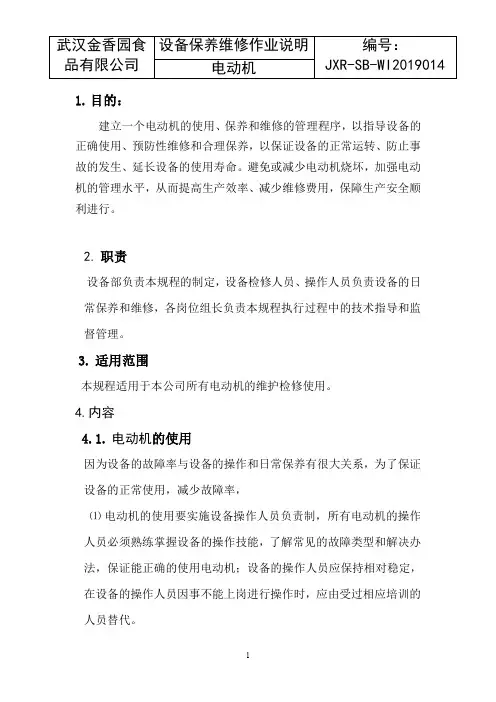
1.目的:建立一个电动机的使用、保养和维修的管理程序,以指导设备的正确使用、预防性维修和合理保养,以保证设备的正常运转、防止事故的发生、延长设备的使用寿命。
避免或减少电动机烧坏,加强电动机的管理水平,从而提高生产效率、减少维修费用,保障生产安全顺利进行。
2.职责设备部负责本规程的制定,设备检修人员、操作人员负责设备的日常保养和维修,各岗位组长负责本规程执行过程中的技术指导和监督管理。
3.适用范围本规程适用于本公司所有电动机的维护检修使用。
4.内容4.1.电动机的使用因为设备的故障率与设备的操作和日常保养有很大关系,为了保证设备的正常使用,减少故障率,⑴电动机的使用要实施设备操作人员负责制,所有电动机的操作人员必须熟练掌握设备的操作技能,了解常见的故障类型和解决办法,保证能正确的使用电动机;设备的操作人员应保持相对稳定,在设备的操作人员因事不能上岗进行操作时,应由受过相应培训的人员替代。
⑵电动机的使用要制定操作规程,要求操作规程的内容要详细、清楚、符合生产工艺对设备操作的要求。
⑶电动机的使用要统计故障率、停机时间,便于对设备的运情况进行检查和分析。
⑷设备的运载负荷是设备的参数之一,严禁设备超负荷运转,严禁设备带病运转。
4.2电动机的保养设备的维修保养应贯彻预防性维修为主的方针,通过日常保养加计划检修的制度加以实施,即在设备故障发生之前按照检修计划或相应的技术规定进行维修保养。
机修工对设备负有维修的责任,定时和经常检查设备的运转情况并经常向操作工了解设备运转的状况,发现隐忧及时予以消除。
4.3日常维护电动机就是利用电磁感应原理,将电能转化为机械能的一种旋转的电气设备。
公司常用的电动机有:交流、直流电动机。
公司中大多数为三相异步电动机,电动机整体形状是一个圆柱体,主要部件有转子和定子。
定子是一对能产生磁场的固定电磁极。
装在定子中间的是一个能转动的电磁体叫转子。
转子是由特种材料作成的圆柱体,套在电动机轴上。
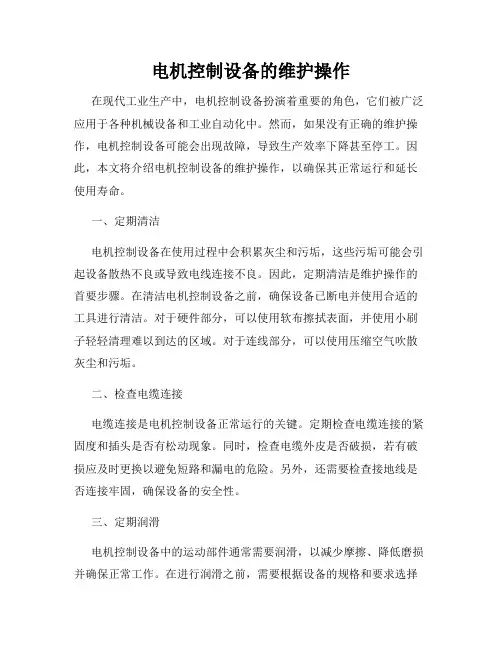
电机控制设备的维护操作在现代工业生产中,电机控制设备扮演着重要的角色,它们被广泛应用于各种机械设备和工业自动化中。
然而,如果没有正确的维护操作,电机控制设备可能会出现故障,导致生产效率下降甚至停工。
因此,本文将介绍电机控制设备的维护操作,以确保其正常运行和延长使用寿命。
一、定期清洁电机控制设备在使用过程中会积累灰尘和污垢,这些污垢可能会引起设备散热不良或导致电线连接不良。
因此,定期清洁是维护操作的首要步骤。
在清洁电机控制设备之前,确保设备已断电并使用合适的工具进行清洁。
对于硬件部分,可以使用软布擦拭表面,并使用小刷子轻轻清理难以到达的区域。
对于连线部分,可以使用压缩空气吹散灰尘和污垢。
二、检查电缆连接电缆连接是电机控制设备正常运行的关键。
定期检查电缆连接的紧固度和插头是否有松动现象。
同时,检查电缆外皮是否破损,若有破损应及时更换以避免短路和漏电的危险。
另外,还需要检查接地线是否连接牢固,确保设备的安全性。
三、定期润滑电机控制设备中的运动部件通常需要润滑,以减少摩擦、降低磨损并确保正常工作。
在进行润滑之前,需要根据设备的规格和要求选择适当的润滑剂。
润滑剂应定期添加,并保持适量的润滑。
同时,需要确保润滑剂的质量,避免使用不合格的润滑剂对设备造成损害。
四、检查电路电机控制设备的电路是其运行的核心部分。
定期检查设备电路的连接是否正常,排查可能存在的断路、短路或绝缘损坏等问题。
可以使用万用表对电路进行测量,确保电压、电流和电阻的数值符合设备规格要求。
如果发现异常,应及时修复或更换受损部件。
五、保持通风和散热电机控制设备在工作时会产生一定的热量,因此良好的通风和散热是保证设备正常工作的重要条件。
确保设备周围没有遮挡物,以保证充足的空气流通量。
另外,还可以根据设备的要求安装散热风扇或散热片,提高设备的散热效果。
同时,定期检查散热器和风扇是否正常工作,确保设备的温度控制在安全范围内。
结语电机控制设备的维护操作是确保设备正常运行和延长使用寿命的重要手段。
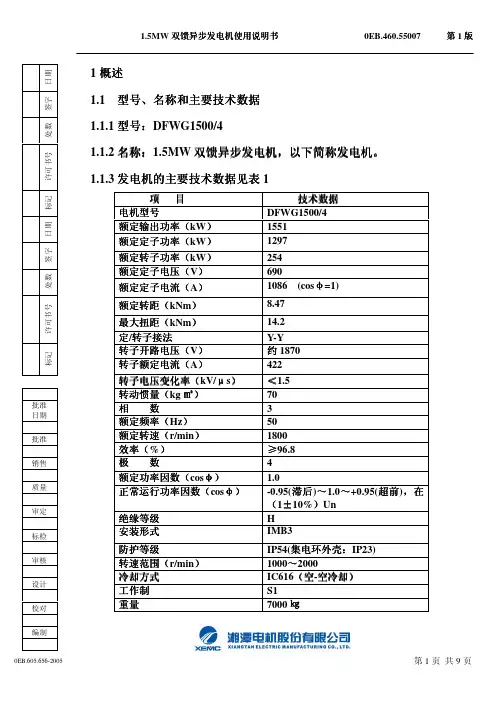
一.储存及运输电动机由制造厂装箱后、在运输途中不得拆箱。
电动机在拆箱后、即行清除尘污,并将露出之表面擦净(如无油漆之轴伸端及滑环等)。
清除原来涂上的临时涂料以及表面之潮气及锈渍等。
如用煤油或汽油将油渍擦净而仍有锈渍时,可用0号细砂布加油轻轻擦光。
电动机运到后如不立即安装,也应拆箱清理并检查如上,并应以防锈油漆或临时性涂封材料将裸露之金属表面重新涂封。
为了防止滑环的工作表面形成斑点、在滑环炭刷间必须垫以绝缘板纸。
在检查涂封后,可在清洁而干净的地方将电动机重新装箱封固。
装箱地点之空气内不应有酸碱等腐蚀性气体存在,以免损坏绝缘及裸露之导电部分。
仓库内温度应经常保持在+3℃以上,空气应干燥、通风良好,每半年应开箱检查一次,视其临时性涂封是否变质,以便及时改进保存情况。
运输时必须防止电动机翻身,以免损坏电动机。
中型电动机应在装配完整后运输,不可在拆开情况下运输,因为电动机在制造厂运输前已经检查、试验及装箱等手续。
在装箱运输时,电动机必须固定在箱底上,箱内部有防潮纸、油毛毡等衬垫。
注意:禁用顶罩上的吊攀起吊整台电机。
如果较重的联轴器或其它的附件使起吊不平衡,则应另加吊索以防倾倒。
中、大容量的电机往往备有转子固定装置以防转子的轴向移动。
搬动整台电机时,必须装上转子固定装置。
不装固定装置可能因转子轴向移动而发生轴承损伤。
二. 电动机启动前的准备新安装的电动机启动前应该要注意以下几点:1.机房内清除垃圾灰尘。
2.检查滤尘器及冷却器装置情况(如无则不需)。
3.仔细检查电动机的可触及的内部,检查电动机内部是否有杂物,并且用干燥的压缩空气(不大于2个大气压)吹净内部。
若没有压缩空气,则可使用手风箱吹。
为了防止损坏线圈绝缘,不要使用金属喷嘴。
4.动机需经干燥处理。
5.检查线路电压、频率、相数是否符合电动机铭牌上所示的数值(允许电压偏差±5%)。
6.根据相应的线路接法检查电动机所有出线端是否正确地连接到线路上(见图2)。
电机维护保养作业指导书1.范围本标准规定了100KW及以下功率的交流三相异步电动机的检修方法。
适用于xxxx大厦所有100KW及以下功率的交流三相异步电动机的检修作业。
本作业指导书不适用于非三相交流异步电动机的检修工作。
1编制依据/引用文件2.1 国家《电气装置安装工程旋转电机施工及验收规范》(GB50170-92)2.2 电动机随机技术文件2术语2.1电动机:又称感应电动机,是一种将电能转变为机械能的电气设备。
按使用电能的种类不同,电动机可分为直流电动机和交流电动机,按电源相数分,交流电动机又可分为单相和三相电动机。
4 检修作业必须具备的条件4.1 经检测确定为电动机内部故障。
4.2 电动机与机械设备完全脱离。
4.3 查看电动机铭牌,了解电动机的有关参数及运行状况。
4.4 具备相应的起吊设备和工作场地。
4.5 作业场所光线充足,通风良好。
5 检修作业程序5.1 检修作业程序方框图5.2 检修作业程序5.2.1 检修5.2.1.1 解体前检查5.2.1.2 检修项目(1)检查电动机外壳是否完好,无锈蚀。
(2)检查引出线连接及绝缘状况,对地绝缘电阻应大于1MΩ,定子绕组绝缘应大于0.5 MΩ。
(3)测量定子、转子线圈及电缆线路的绝缘电阻。
(4)检查电动机的起动装置及附属设备。
(5)外观检查电动机外壳接地应紧固无锈蚀。
(6)通电试验,测空载电流,听运转声音。
测空载电流的方法如下:①断开要测试的电动机负载,若是离心水泵,可以关闭进水阀门;若是风机,可以关闭进风阀;若是潜水泵,则需将泵体提出水面;②若电动机没有与设备直接分离,对泵类,空载运行时间不得超过5min;若电动机与设备已经分离,则要注意转轴上及附近应无杂物,电动机要放在平坦的地面,根据电动机铭牌上的额定电压和额定电流值,选用合适的控制开关,接通电源;③启动电动机进行测试,用万用表检测电源电压,三相额定电压波动<±5%为合格。
电压正常后,用钳形电流表检测电动机各相电流,检测值应在本作业指导书6.4条表中数值范围内。
运行和维护手册DFWG1500/4双馈异步风力发电机2010年05月出版目录1 安全规范 (4)1.1 注意 (4)1.2 定义,警告 (4)1.3 安全和应用规范 (5)1.4 处理方法 (6)1.5 制造商声明................................................................ 错误!未定义书签。
1.6 符合性声明................................................................ 错误!未定义书签。
2 描述/技术数据 (7)2.1 用途 (7)2.2 解释 (7)2.2.1 定子 (7)2.2.2 转子 (8)2.2.3 静态加热器 (8)2.2.4 减磨滚柱轴承 (8)2.2.5 冷却和通风 (9)2.2.6 监控设备 (9)2.2.7 滑环室 (9)2.2.8 电气连接 (10)2.3 技术数据 (10)2.4 相关图纸 (11)3 安装/装配 (19)3.1 运输,存储 (19)3.1.1 运输后的检查 (20)3.1.2 存储防范 (20)3.2 吊装 (20)3.3 固定 (21)3.4 连接............................................................................ 错误!未定义书签。
3.4.1 基础配置 (21)3.4.2 装配联轴器 (22)3.4.3 粗略连接 (22)3.4.4 精细连接.......................................................... 错误!未定义书签。
3.5 定子绕组连接 (23)3.6 接地电缆连接 (24)3.7 辅助电路连接 (24)3.8 收尾工作 (24)3.9 螺栓连接的扳紧扭矩 (24)3.10 在长时间停机或存储之后检查轴承润滑 (25)4 试车 (25)4.1 准备 (25)4.1.1 检查绝缘电阻 (26)4.1.2 收尾工作 (28)4.2 接通 (28)5 参数 (28)5.1 极限温度 (28)6 运行 (29)6.1 接通 (29)6.2 停机期间 (29)7 维护 (30)7.1 维护 (30)7.1.1 维护时间表 (30)7.1.2 常规清理和维护检查 (31)7.1.3 维护减摩轴承 (31)7.1.4 维护电刷 (33)7.1.5 维护滑环 (35)7.1.6 清洁滑环室 (36)8 一般说明 (36)8.1 备件清单 (36)9附加的使用说明书(可选,其它供应商) (37)10.1 速度监控器 (37)注意由于各种原因,此运行规范没有包括所有的细节并且可能没有考虑某些单独的应用模块。
电动机运行维护规程范本电动机是工业生产中广泛使用的一种电动设备,它为工作设备提供动力,并且在许多领域中发挥着重要的作用。
为了保证电动机的正常运行和延长其使用寿命,有必要制定一套运行维护规程。
本文将为您介绍一份电动机运行维护规程范本,以下为其详细内容:一、电动机的日常检查及维护1. 定期检查电动机的外观是否完好,有无损坏、渗漏等情况。
2. 检查电动机的通风设备是否正常运行,清理通风道路的灰尘和杂物。
3. 检查电动机的轴承是否润滑良好,必要时添加或更换润滑油。
4. 检查电动机的绕组是否出现异常,如温度过高等情况,及时处理。
5. 定期检查电动机的绝缘电阻,确保其达到规定的要求。
6. 检查电动机的定子和转子是否有松动或异常噪音,及时进行修复或更换。
二、电动机的运行注意事项1. 在启动电动机前,应确保其电源和负载设备的状态正常。
2. 电动机在启动前,应检查其电源电压是否符合要求,是否有过载保护装置。
3. 电动机的启动次数和运行时间应符合设计要求,避免频繁启停或长时间连续运行。
4. 在电动机运行期间,应注意电流和电压的波动情况,避免过载运行。
5. 电动机在运行时,应注意负载的变化情况,及时调整电机的工作方式以适应负载需求。
6. 当电动机出现异常情况时,应立即停机检修,并寻找故障原因进行排除。
三、电动机的维护保养措施1. 定期检查电动机的润滑系统,并及时更换和添加润滑油。
2. 定期清理电动机的风道和散热片,确保通风设备的正常运行。
3. 定期检查电动机的接线端子和连接螺栓是否松动,及时进行紧固。
4. 定期检查电动机的轴承和密封装置,确保其正常工作。
5. 定期清洁电动机的外壳和表面,保持其整洁、干燥。
6. 经常检查电动机的运行记录和维护记录,及时发现问题并进行处理。
四、电动机的安全操作注意事项1. 在操作电动机时,必须穿戴合适的工作服和个人防护装备,并确保工作场所的安全。
2. 在对电动机进行检修和维护时,必须切断电源,并采取相应的安全措施。